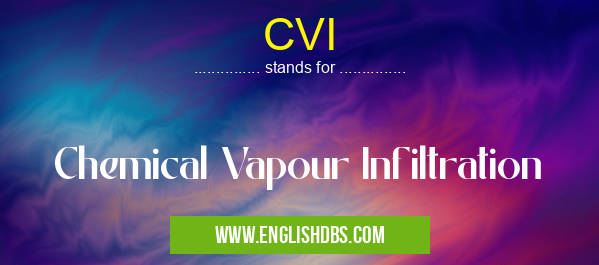What does CVI mean in CHEMISTRY
CVI stands for Chemical Vapor Infiltration. It is a process used to deposit materials into a porous substrate by infiltrating it with a chemical vapor. The process involves the introduction of a precursor gas into a reaction chamber containing the substrate, where it undergoes a chemical reaction to form the desired material. CVI is widely used in various industries, including aerospace, automotive, electronics, and biomedical, to produce high-performance materials with unique properties.

CVI meaning in Chemistry in Academic & Science
CVI mostly used in an acronym Chemistry in Category Academic & Science that means Chemical Vapour Infiltration
Shorthand: CVI,
Full Form: Chemical Vapour Infiltration
For more information of "Chemical Vapour Infiltration", see the section below.
CVI Process
The CVI process typically involves the following steps:
-
Substrate Preparation: The substrate is first cleaned and prepared to ensure proper adhesion and infiltration.
-
Precursor Gas Introduction: A precursor gas, containing the desired material in a vapor form, is introduced into the reaction chamber.
-
Chemical Reaction: The precursor gas reacts with the substrate, typically at elevated temperatures, to form the desired material.
-
Infiltration: The reaction products infiltrate into the pores of the substrate, leading to the deposition of the material.
-
Growth Control: The process conditions, such as temperature, pressure, and gas flow rates, are carefully controlled to achieve the desired material properties and infiltration depth.
Advantages of CVI
CVI offers several advantages, including:
-
Conformal Deposition: CVI enables the deposition of materials into complex shapes and porous structures, ensuring uniform coating.
-
Tailored Material Properties: The process parameters can be adjusted to control the material's properties, such as density, porosity, and composition.
-
High-Temperature Resistance: CVI materials can withstand high temperatures, making them suitable for applications in harsh environments.
-
Corrosion Resistance: CVI coatings can provide corrosion protection for underlying substrates.
Applications of CVI
CVI has a wide range of applications, including:
-
Aerospace: Producing lightweight and high-strength composites for aircraft structures.
-
Automotive: Fabricating catalytic converters, exhaust systems, and fuel injectors.
-
Electronics: Coating printed circuit boards and creating interconnects.
-
Biomedical: Developing biocompatible implants, scaffolds for tissue engineering, and drug delivery systems.
Essential Questions and Answers on Chemical Vapour Infiltration in "SCIENCE»CHEMISTRY"
What is Chemical Vapour Infiltration (CVI)?
CVI is a fabrication technique used to deposit materials into the pores of a porous preform through the chemical reaction of gaseous precursors. It involves infiltrating a porous substrate with a gaseous chemical precursor that undergoes a chemical reaction within the pores, depositing the desired material. This process is often used to produce high-performance materials with unique properties, such as ceramics and composites.
What are the advantages of CVI?
CVI offers several advantages, including:
- Conformal coating: CVI enables the deposition of materials into complex and intricate shapes, providing conformal coverage and precise control over the material's thickness and microstructure.
- High purity: The chemical reactions involved in CVI typically result in the formation of high-purity materials with minimal defects.
- Tailorable properties: By controlling the composition and processing parameters, the properties of the deposited material can be tailored to meet specific requirements.
- Near-net shape fabrication: CVI allows for the production of near-net shape components, reducing the need for post-processing and minimizing material waste.
What are the applications of CVI?
CVI is widely used in various industries, including:
- Aerospace: CVI is employed to produce lightweight and high-strength materials for aircraft components, such as turbine blades and heat shields.
- Electronics: CVI is utilized to deposit thin films and coatings for electronic devices, including semiconductors and capacitors.
- Biomedical: CVI is used to create porous scaffolds for tissue engineering and to coat medical implants with biocompatible materials.
- Energy: CVI is used to produce materials for fuel cells, batteries, and other energy storage devices.
What are the challenges associated with CVI?
CVI faces some challenges, such as:
- Process control: The CVI process requires careful control of temperature, pressure, and gas flow to achieve the desired material properties and prevent defects.
- Porosity: The porosity of the preform can affect the deposition rate and the uniformity of the deposited material.
- Scaling up: Scaling up the CVI process for large-scale production can be challenging due to the need for precise control and specialized equipment.
Final Words: CVI is a versatile and powerful technique for the deposition of materials into porous substrates. It offers precise control over material properties and enables the production of high-performance materials with tailored properties. The unique capabilities of CVI make it an essential tool in various industries, providing innovative solutions for demanding applications.
CVI also stands for: |
|
| All stands for CVI |
